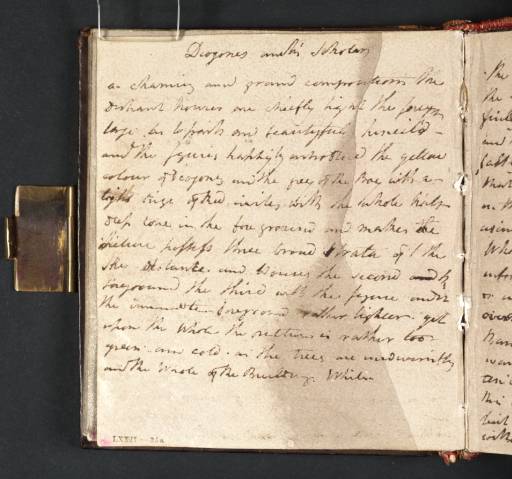Joseph Mallord William Turner Commentary on Nicolas Poussin's 'Landscape with Diogenes' (Inscription by Turner) 1802
Joseph Mallord William Turner,
Commentary on Nicolas Poussin's 'Landscape with Diogenes' (Inscription by Turner)
1802
Joseph Mallord William Turner 1775–1851
Folio 25 Verso:
Commentary on Nicolas Poussin’s ‘Landscape with Diogenes’ (Inscription by Turner) 1802
D04302
Turner Bequest LXXII 25a
Turner Bequest LXXII 25a
Inscribed by Turner in black ink (see main catalogue entry) on white wove paper prepared with a pale reddish brown wash, 128 x 114 mm
Stamped in black ‘LXXII–25a’ bottom left
Stamped in black ‘LXXII–25a’ bottom left
Accepted by the nation as part of the Turner Bequest 1856
References
1909
A.J. Finberg, A Complete Inventory of the Drawings of the Turner Bequest, London 1909, vol.I, p.183, LXXII 25a.
1961
Alexander J. Finberg, The Life of J.M.W. Turner, R.A. Second Edition, Revised, with a Supplement, by Hilda F. Finberg, revised ed., Oxford 1961, p.89.
1963
Jerrold Ziff, ‘Turner and Poussin’, The Burlington Magazine, vol.105, 1963, p.319 note 21.
1965
Jerrold Ziff, ‘Copies of Claude’s Paintings in the Sketchbooks of J.M.W. Turner’, Gazette des Beaux-Arts, vol.65, 1965, p.64 note 27.
1966
Jack Lindsay, Turner: His Life and Work, London 1966, pp.79.
1969
John Gage, Colour in Turner: Poetry and Truth, London 1969, p.31.
1983
Jerrold Ziff, ‘Turner et les grands maîtres’, in J.M.W. Turner, exhibition catalogue, Grand Palais, Paris 1983, p.25 note 7.
1995
Richard Verdi, Nicolas Poussin, exhibition catalogue, Royal Academy of Arts, London 1995, p.282.
Turner’s remarks read:
Diogenes and his Scholars. | a charming and grand composition the | distant houses are chiefly light the foreground | large as to parts and beautifully pencil’d – | and the figures happily introduced the yellow | colour of Diogenes and the gray of the Boy with a light tinge [Finberg: ? toga] of Red unites the whole half | deep tone in the foreground and makes the | picture possess three broad strata of the | sky distance and Houses the second the | foreground the third with the figure and | the immediate foreground rather lighter. Yet | upon the whole the picture is rather too | green and cold as the Trees are undeservedly | and the Whole of the Buildings White.
Finberg correctly surmised that the subject of Turner’s notes was ‘Poussin’s “Diogène jetant son écueille”’. The Cynic philosopher is moved to cast aside his last worldly possession, his drinking bowl, by seeing a man taking water from his cupped hands. The anachronistic title – ‘Diogenes and his Scholars’ – with which Turner headed his notes doubtless arose from a hasty confusion of écueille with école. The picture, which has an exquisite wooded landscape setting, dates from 1648 or perhaps later. It was one of the group of pictures by Poussin (Nicolas Poussin 1594–1665) acquired by Louis XIV from the collection of the Duc de Richelieu. Nineteenth-century artists and critics gave it a special place among the Louvre’s Poussins for its landscape qualities. Turner made a copy of it in his Dieppe, Rouen, Paris sketchbook when in the Louvre again in 1821 (Tate D24537; Turner Bequest CCLVIII 20). On this later occasion he mistakenly attributed it to Gaspard Poussin. Turner’s observation in 1802 of the picture’s tonal ‘strata’ relates to his own habit of dividing pictorial planes into distinct colours or tones, a practice first apparent in seventeenth- and early eighteenth-century Flemish landscape painting. Turner was clearly alert to the way in which the contrast between the verdant landscape and the background buildings amplifies the theme of the rejection of worldly goods and a return to nature. The ‘distant houses’ include the Belvedere of the Vatican.
Poussin, a pre-eminent inspiration for Turner’s early historical landscapes and sombre palette, was one of his main objects of study in 1802. Turner copied or commented on ten pictures: besides the Diogenes, whose title he also noted in shorthand with a colour key on folio 73 (D04368), and again on folio 90 (D04390), the sketchbook contains material on Orpheus and Eurydice, The Gathering of the Manna, The Woman Taken in Adultery, The Death of Sapphira, The Plague of Ashdod, Eleazer and Rebecca at the Well, The Childhood of Jupiter, The Judgment of Solomon and The Deluge. See, variously, folios 26, 26 verso, 27, 40 verso, 41, 71, 73; 74 (D04303, D04304, D04305, D04327, D04328, D04366, D04368, D04369). Taken together with his later observations in his Royal Academy Perspective lectures, chiefly his ‘Backgrounds’ lecture of 1811, his criticism constitutes the most important and sustained British analysis of the artist since that of Joshua Reynolds in his Academy Discourses (1769–90), which it references but also advances. While not uncritical of Poussin, Turner regarded him as a master of the Sublime whose colouring did not necessarily make any claim to truth but was designed to transport the mind back to antiquity and express the mood of his subjects. The best recent summary of Turner’s views is Michael Kitson’s.1
David Blayney Brown
July 2005
How to cite
David Blayney Brown, ‘Commentary on Nicolas Poussin’s ‘Landscape with Diogenes’ (Inscription by Turner) 1802 by Joseph Mallord William Turner’, catalogue entry, July 2005, in David Blayney Brown (ed.), J.M.W. Turner: Sketchbooks, Drawings and Watercolours, Tate Research Publication, December 2012, https://www

